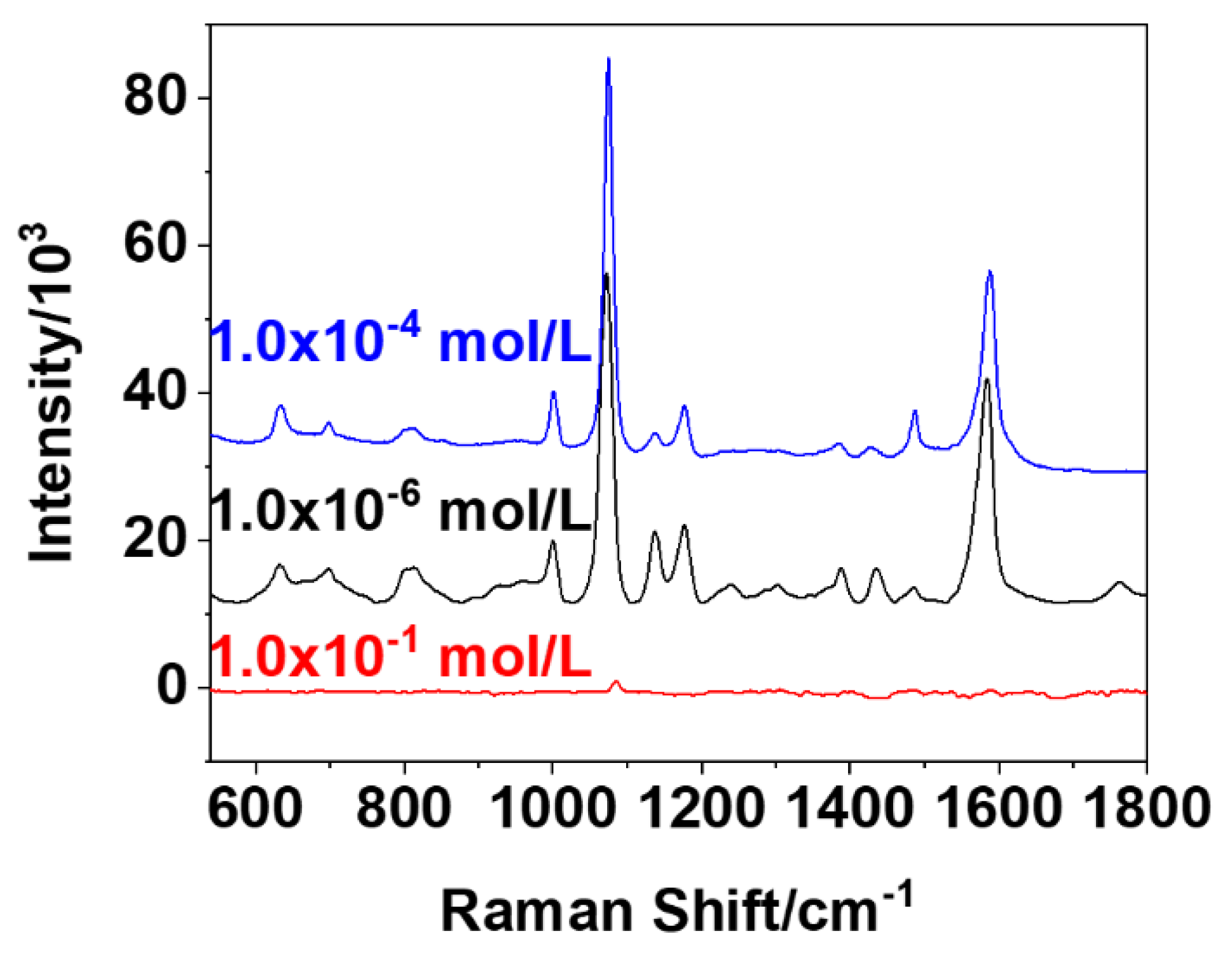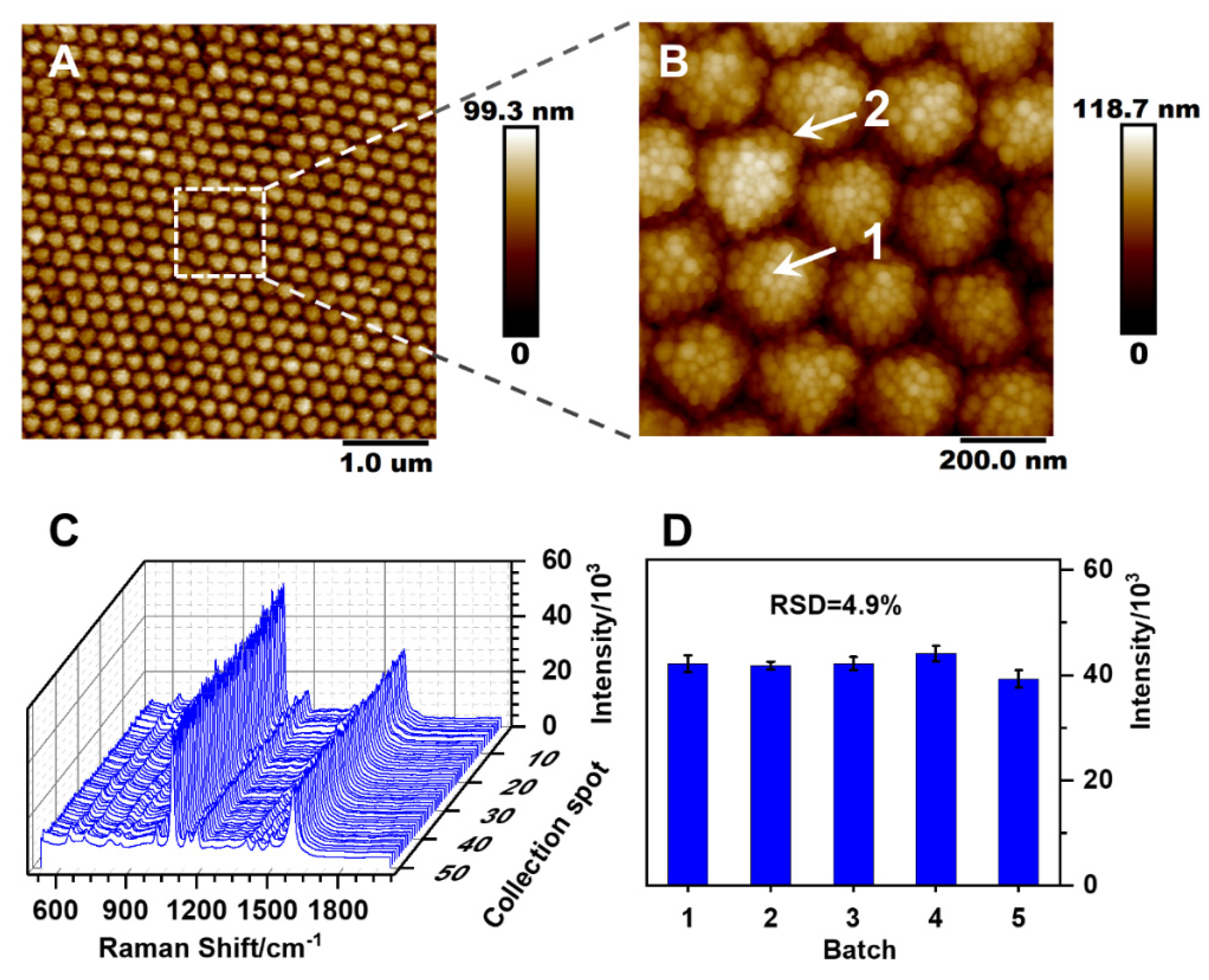Preparation of Monolayer Photonic Crystals from Ag Nanobulge-Deposited SiO2 Particles as Substrates for Reproducible SERS Assay of Trace Thiol Pesticide
Abstract
1. Introduction
2. Materials and Methods
2.1. Materials and Reagents
2.2. Synthesis of SiO2@nAg
2.3. Preparation of SiO2@nAg-Based PC and Other Substrates
2.4. PC-Based SERS Assay of Thiram in Food
2.5. Other Measurements
3. Results and Discussion
3.1. Conditions to Synthesize SiO2@nAg
3.2. Assembly of Monolayer PCs from SiO2@nAg
3.3. SERS Performance of SiO2@nAg-Based Monlayer PCs
3.4. Methodological Features and Application
4. Conclusions
Supplementary Materials
Author Contributions
Funding
Acknowledgments
Conflicts of Interest
References
- Vankeirsbilck, T.; Vercauteren, A.; Baeyens, W.; Van der Weken, G.; Verpoort, F.; Vergote, G.; Remon, J.P. Applications of Raman spectroscopy in pharmaceutical analysis. TrAC Trends Anal. Chem. 2002, 21, 869–877. [Google Scholar] [CrossRef]
- Zhang, Z.; Bando, K.; Mochizuki, K.; Taguchi, A.; Fujita, K.; Kawata, S. Quantitative evaluation of surface-enhanced Raman scattering nanoparticles for intracellular pH sensing at a single particle level. Anal. Chem. 2019, 91, 3254–3262. [Google Scholar] [CrossRef]
- Zong, C.; Xu, M.; Xu, L.-J.; Wei, T.; Ma, X.; Zheng, X.-S.; Hu, R.; Ren, B. Surface-enhanced Raman spectroscopy for bioanalysis: Reliability and challenges. Chem. Rev. 2018, 118, 4946–4980. [Google Scholar] [CrossRef] [PubMed]
- Li, J.F.; Huang, Y.F.; Ding, Y.; Yang, Z.L.; Li, S.B.; Zhou, X.S.; Fan, F.R.; Zhang, W.; Zhou, Z.Y.; Wu, D.Y.; et al. Shell-isolated nanoparticle-enhanced Raman spectroscopy. Nature 2010, 464, 392–395. [Google Scholar] [CrossRef]
- Li, J.; Yan, H.; Tan, X.; Lu, Z.; Han, H. Cauliflower-inspired 3D SERS substrate for multiple mycotoxins detection. Anal. Chem. 2019, 91, 3885–3892. [Google Scholar] [CrossRef]
- Xu, M.-L.; Gao, Y.; Han, X.X.; Zhao, B. Detection of pesticide residues in food using surface-enhanced Raman spectroscopy: A review. J. Agric. Food. Chem. 2017, 65, 6719–6726. [Google Scholar] [CrossRef] [PubMed]
- Zhang, C.; You, T.; Yang, N.; Gao, Y.; Jiang, L.; Yin, P. Hydrophobic paper-based SERS platform for direct-droplet quantitative determination of melamine. Food Chem. 2019, 287, 363–368. [Google Scholar] [CrossRef] [PubMed]
- Chen, M.; Luo, W.; Liu, Q.; Hao, N.; Zhu, Y.; Liu, M.; Wang, L.; Yang, H.; Chen, X. Simultaneous in situ extraction and fabrication of surface-enhanced Raman scattering substrate for reliable detection of thiram residue. Anal. Chem. 2018, 90, 13647–13654. [Google Scholar] [CrossRef]
- Cui, K.; Fan, C.; Chen, G.; Qiu, Y.; Li, M.; Lin, M.; Wan, J.B.; Cai, C.; Xiao, Z. para-Aminothiophenol radical reaction-functionalized gold nanoprobe for one-to-all detection of five reactive oxygen species in vivo. Anal. Chem. 2018, 90, 12137–12144. [Google Scholar] [CrossRef]
- Chirumamilla, M.; Toma, A.; Gopalakrishnan, A.; Das, G.; Zaccaria, R.P.; Krahne, R.; Rondanina, E.; Leoncini, M.; Liberale, C.; De Angelis, F.; et al. 3D nanostar dimers with a sub-10-nm gap for single-/few-molecule surface-enhanced Raman scattering. Adv. Mater. 2014, 26, 2353–2358. [Google Scholar] [CrossRef]
- Hu, M.; Ou, F.S.; Wu, W.; Naumov, I.; Li, X.; Bratkovsky, A.M.; Williams, R.S.; Li, Z. Gold nanofingers for molecule trapping and detection. J. Am. Chem. Soc. 2010, 132, 12820–12822. [Google Scholar] [CrossRef] [PubMed]
- Zhu, X.; Wang, W.; Yan, W.; Larsen, M.B.; Bøggild, P.; Pedersen, T.G.; Xiao, S.; Zi, J.; Mortensen, N.A. Plasmon–phonon coupling in large-area graphene dot and antidot arrays fabricated by nanosphere lithography. Nano Lett. 2014, 14, 2907–2913. [Google Scholar] [CrossRef] [PubMed]
- Lee, S.; Shin, J.; Lee, Y.-H.; Park, J.-K. Fabrication of the funnel-shaped three-dimensional plasmonic tip arrays by directional photofluidization lithography. ACS Nano 2010, 4, 7175–7184. [Google Scholar] [CrossRef] [PubMed]
- Peng, B.; Li, G.; Li, D.; Dodson, S.; Zhang, Q.; Zhang, J.; Lee, Y.H.; Demir, H.V.; Yi Ling, X.; Xiong, Q. Vertically aligned gold nanorod monolayer on arbitrary substrates: Self-assembly and femtomolar detection of food contaminants. ACS Nano 2013, 7, 5993–6000. [Google Scholar] [CrossRef] [PubMed]
- Mirkin, C.A.; Letsinger, R.L.; Mucic, R.C.; Storhoff, J.J. A DNA-based method for rationally assembling nanoparticles into macroscopic materials. Nature 1996, 382, 607–609. [Google Scholar] [CrossRef]
- Wang, H.; Li, Y.; Liu, M.; Gong, M.; Deng, Z. Overcoming the coupling dilemma in DNA-programmable nanoparticle assemblies by “Ag+ soldering”. Small 2015, 11, 2247–2251. [Google Scholar] [CrossRef]
- Mistark, P.A.; Park, S.; Yalcin, S.E.; Lee, D.H.; Yavuzcetin, O.; Tuominen, M.T.; Russell, T.P.; Achermann, M. Block-copolymer-based plasmonic nanostructures. ACS Nano 2009, 3, 3987–3992. [Google Scholar] [CrossRef]
- Park, Y.-K.; Yoo, S.-H.; Park, S. Assembly of highly ordered nanoparticle monolayers at a water/hexane interface. Langmuir 2007, 23, 10505–10510. [Google Scholar] [CrossRef]
- Qiao, X.; Xue, Z.; Liu, L.; Liu, K.; Wang, T. Superficial-layer-enhanced Raman scattering (SLERS) for depth detection of noncontact molecules. Adv. Mater. 2019, 31, 1804275. [Google Scholar] [CrossRef]
- Li, J.; Liu, J.; Chen, Y. Matrix-assisted laser ablation production of gold cluster ions from Au-coated photonic crystals. J. Mass Spectrom. 2012, 47, 620–626. [Google Scholar] [CrossRef]
- Liao, T.; Guo, Z.; Li, J.; Liu, M.; Chen, Y. One-step packing of anti-voltage photonic crystals into microfluidic channels for ultra-fast separation of amino acids and peptides. Lab Chip 2013, 13, 706–713. [Google Scholar] [CrossRef]
- Hu, C.; Chen, Y. Uniformization of silica particles by theory directed rate-zonal centrifugation to build high quality photonic crystals. Chem. Eng. J. 2015, 271, 128–134. [Google Scholar] [CrossRef]
- Chen, Y.; Zhang, C.; Zheng, Q.; Chen, Y. Separation-cooperated assembly of liquid photonic crystals from polydisperse particles. Chem. Commun. 2018, 54, 13937–13940. [Google Scholar] [CrossRef] [PubMed]
- Zhang, J.T.; Wang, L.; Lamont, D.N.; Velankar, S.S.; Asher, S.A. Fabrication of large-area two-dimensional colloidal crystals. Angew. Chem. Int. Ed. 2012, 51, 6117–6120. [Google Scholar] [CrossRef] [PubMed]
- Smith, N.L.; Coukouma, A.; Dubnik, S.; Asher, S.A. Debye ring diffraction elucidation of 2D photonic crystal self-assembly and ordering at the air–water interface. Phys. Chem. Chem. Phys. 2017, 19, 31813–31822. [Google Scholar] [CrossRef] [PubMed]
- Gao, P.; He, J.; Zhou, S.; Yang, X.; Li, S.; Sheng, J.; Wang, D.; Yu, T.; Ye, J.; Cui, Y. Large-area nanosphere self-assembly by a micro-propulsive injection method for high throughput periodic surface nanotexturing. Nano Lett. 2015, 15, 4591–4598. [Google Scholar] [CrossRef]
- Li, Y.J.; Huang, W.J.; Sun, S.G. A universal approach for the self-assembly of hydrophilic nanoparticles into ordered monolayer films at a toluene/water interface. Angew. Chem. Int. Ed. 2006, 45, 2537–2539. [Google Scholar] [CrossRef]
- Zhang, K.; Ji, J.; Li, Y.; Liu, B. Interfacial self-assembled functional nanoparticle array: A facile surface-enhanced Raman scattering sensor for specific detection of trace analytes. Anal. Chem. 2014, 86, 6660–6665. [Google Scholar] [CrossRef]
- Yang, J.-K.; Kang, H.; Lee, H.; Jo, A.; Jeong, S.; Jeon, S.-J.; Kim, H.-I.; Lee, H.-Y.; Jeong, D.H.; Kim, J.-H.; et al. Single-step and rapid growth of silver nanoshells as SERS-active nanostructures for label-free detection of pesticides. ACS Appl. Mater. Interfaces 2014, 6, 12541–12549. [Google Scholar] [CrossRef]
- Kang, H.; Yang, J.-K.; Noh, M.S.; Jo, A.; Jeong, S.; Lee, M.; Lee, S.; Chang, H.; Lee, H.; Jeon, S.-J.; et al. One-step synthesis of silver nanoshells with bumps for highly sensitive near-IR SERS nanoprobes. J. Mater. Chem. B 2014, 2, 4415–4421. [Google Scholar] [CrossRef]
- Wong, S.; Kitaev, V.; Ozin, G.A. Colloidal crystal films: Advances in universality and perfection. J. Am. Chem. Soc. 2003, 125, 15589–15598. [Google Scholar] [CrossRef]
- Sun, K.; Meng, G.; Huang, Q.; Zhao, X.; Zhu, C.; Huang, Z.; Qian, Y.; Wang, X.; Hu, X. Gap-tunable Ag-nanorod arrays on alumina nanotip arrays as effective SERS substrates. J. Mater. Chem. C 2013, 1, 5015–5022. [Google Scholar] [CrossRef]
- Cereser, C.; Boget, S.; Parvaz, P.; Revol, A. Thiram-induced cytotoxicity is accompanied by a rapid and drastic oxidation of reduced glutathione with consecutive lipid peroxidation and cell death. Toxicology 2001, 163, 153–162. [Google Scholar] [CrossRef]
- Filipe, O.M.S.; Vidal, M.M.; Duarte, A.C.; Santos, E.B.H. A solid-phase extraction procedure for the clean-up of thiram from aqueous solutions containing high concentrations of humic substances. Talanta 2007, 72, 1235–1238. [Google Scholar] [CrossRef] [PubMed]
- Peruga, A.; Grimalt, S.; López, F.J.; Sancho, J.V.; Hernández, F. Optimisation and validation of a specific analytical method for the determination of thiram residues in fruits and vegetables by LC–MS/MS. Food Chem. 2012, 135, 186–192. [Google Scholar] [CrossRef]
- Crnogorac, G.; Schwack, W. Residue analysis of dithiocarbamate fungicides. TrAC Trends Anal. Chem. 2009, 28, 40–50. [Google Scholar] [CrossRef]
- Queffelec, A.-L.; Boisdé, F.; Larue, J.-P.; Haelters, J.-P.; Corbel, B.; Thouvenot, D.; Nodet, P. Development of an immunoassay (ELISA) for the quantification of thiram in Lettuce. J. Agric. Food. Chem. 2001, 49, 1675–1680. [Google Scholar] [CrossRef]
- Maximiano, E.M.; de Lima, F.; Cardoso, C.A.L.; Arruda, G.J. Modification of carbon paste electrodes with recrystallized zeolite for simultaneous quantification of thiram and carbendazim in food samples and an agricultural formulation. Electrochim. Acta 2018, 259, 66–76. [Google Scholar] [CrossRef]







| Detect Method | Limit of Detection | Ref |
|---|---|---|
| Electrochemical method | 1.61 ppb | [38] |
| ELISA | 40.0 ppb | [37] |
| LC-MS/MS | 25.0 ppb | [35,36] |
| SPE-UV | 330 ppb | [34] |
| Ag NS-based SERS | 14.4 ppm | [29] |
| Monolayer PC-based SERS | 34.7 ppb | this work |
© 2020 by the authors. Licensee MDPI, Basel, Switzerland. This article is an open access article distributed under the terms and conditions of the Creative Commons Attribution (CC BY) license (http://creativecommons.org/licenses/by/4.0/).
Share and Cite
Zhang, C.; Xu, J.; Chen, Y. Preparation of Monolayer Photonic Crystals from Ag Nanobulge-Deposited SiO2 Particles as Substrates for Reproducible SERS Assay of Trace Thiol Pesticide. Nanomaterials 2020, 10, 1205. https://doi.org/10.3390/nano10061205
Zhang C, Xu J, Chen Y. Preparation of Monolayer Photonic Crystals from Ag Nanobulge-Deposited SiO2 Particles as Substrates for Reproducible SERS Assay of Trace Thiol Pesticide. Nanomaterials. 2020; 10(6):1205. https://doi.org/10.3390/nano10061205
Chicago/Turabian StyleZhang, Changbo, Jiying Xu, and Yi Chen. 2020. "Preparation of Monolayer Photonic Crystals from Ag Nanobulge-Deposited SiO2 Particles as Substrates for Reproducible SERS Assay of Trace Thiol Pesticide" Nanomaterials 10, no. 6: 1205. https://doi.org/10.3390/nano10061205
APA StyleZhang, C., Xu, J., & Chen, Y. (2020). Preparation of Monolayer Photonic Crystals from Ag Nanobulge-Deposited SiO2 Particles as Substrates for Reproducible SERS Assay of Trace Thiol Pesticide. Nanomaterials, 10(6), 1205. https://doi.org/10.3390/nano10061205






